
A port is a maritime facility comprising one or more wharves or loading areas, where ships load and discharge cargo and passengers. Although usually situated on a sea coast or estuary, ports can also be found far inland, such as Hamburg, Manchester and Duluth; these access the sea via rivers or canals. Because of their roles as ports of entry for immigrants as well as soldiers in wartime, many port cities have experienced dramatic multi-ethnic and multicultural changes throughout their respective histories.

A waterway is any navigable body of water. Broad distinctions are useful to avoid ambiguity, and disambiguation will be of varying importance depending on the nuance of the equivalent word in other languages. A first distinction is necessary between maritime shipping routes and waterways used by inland water craft. Maritime shipping routes cross oceans and seas, and some lakes, where navigability is assumed, and no engineering is required, except to provide the draft for deep-sea shipping to approach seaports (channels), or to provide a short cut across an isthmus; this is the function of ship canals. Dredged channels in the sea are not usually described as waterways. There is an exception to this initial distinction, essentially for legal purposes, see under international waters.

The Intracoastal Waterway (ICW) is a 3,000-mile (4,800 km) inland waterway along the Atlantic and Gulf of Mexico coasts of the United States, running from Boston, southward along the Atlantic Seaboard and around the southern tip of Florida, then following the Gulf Coast to Brownsville, Texas. Some sections of the waterway consist of natural inlets, saltwater rivers, bays, and sounds, while others are artificial canals. It provides a navigable route along its length without many of the hazards of travel on the open sea.
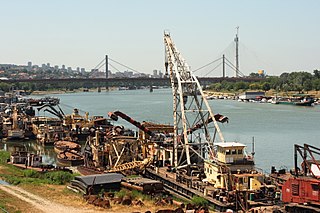
A riverboat is a watercraft designed for inland navigation on lakes, rivers, and artificial waterways. They are generally equipped and outfitted as work boats in one of the carrying trades, for freight or people transport, including luxury units constructed for entertainment enterprises, such as lake or harbour tour boats. As larger water craft, virtually all riverboats are especially designed and constructed, or alternatively, constructed with special-purpose features that optimize them as riverine or lake service craft, for instance, dredgers, survey boats, fisheries management craft, fireboats and law enforcement patrol craft.

The modern terms short-sea shipping, marine highway, and motorways of the sea, and the more historical terms coastal trade, coastal shipping, coasting trade, and coastwise trade, all encompass the movement of cargo and passengers mainly by sea along a coast, without crossing an ocean.

A dry bulk cargo barge is a barge designed to carry freight such as coal, finished steel or its ingredients, grain, sand or gravel, or similar materials. Barges are usually constructed of steel. They have an outer hull, an internal void that is fitted with heavy struts and cross braces or scantlings, and an internal cargo box. The outer hull of a barge can come in one of two configurations. A rake barge has a curved bow to provide less resistance when being pushed and is usually placed at the head of the tow. A box barge is usually placed in the center and rear of the tow and can hold more cargo.
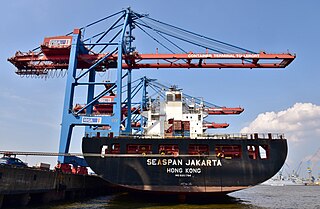
Seaspan ULC provides marine-related services to the Pacific Northwest. Within the Group are three shipyards, an intermodal ferry and car float business, and a tug and barge transportation company that serves both domestic and international markets. Seaspan is part of the Washington Companies, owned by Dennis Washington. Seaspan is run by his son Kyle Washington, as Executive Chairman, who has become a Canadian citizen. Seaspan ULC was formerly known as Seaspan Marine Corporation, and prior to that Washington Marine Group.

The Tulsa Ports is near the city of Catoosa in Rogers County, just inside the municipal fenceline of Tulsa, Oklahoma, United States. Located at the head of navigation for the McClellan-Kerr Arkansas River Navigation System (MKARNS), it handles shipping loads through its waterway access to the Arkansas River via the Verdigris River. TPOC offers year round, ice-free barge service with river flow levels controlled by the U.S. Army Corps of Engineers. It encompasses an area of 2,500 acres (10 km2) and employs over 4,000 people at over 70 companies in its industrial park. The port ships manufactured goods and agricultural products from Oklahoma to the rest of the world. Designated a foreign trade zone, it is a major economic engine for the region with over 2.7 million tons of cargo shipped through the Port in 2013 alone.
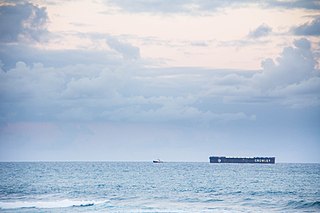
Crowley Maritime Corporation, is based in Jacksonville, Florida. Founded in 1892, Crowley is primarily a family- and employee-owned vessel management, owner, and supply chain logistics services company, providing services globally. As of July 2016, Crowley was ranked as the 13th largest private company in Florida, employing approximately 5,300 people worldwide with revenues of $2.2 billion. It provides its services using a fleet of more than 300 vessels, consisting of RO-RO vessels, LO-LO vessels, tankers, Articulated Tug-Barges (ATBs), tugs and barges. Crowley's land-based facilities and equipment include terminals, warehouses, tank farms, and specialized vehicles.

Kerala State Water Transport Department (SWTD) is a governmental department that regulates the inland navigation systems in the Indian state of Kerala and provides inland water transport facilities. It stands for catering to the traffic needs of the inhabitants of the waterlogged areas of the Districts of Alappuzha, Kottayam, Kollam, Ernakulam, Kannur and Kasaragod. The department is headed by the State Minister in charge of transportation.
Kochi is a major port city in the Indian state of Kerala. The city is widely known as the commercial or economic capital of the state of Kerala.

Inland Waterways Authority of India (IWAI) is the statutory authority in charge of the waterways in India. It was constituted under IWAI Act-1985 by parliament of India Its headquarters is located in Noida, UP. India has an extensive network of inland waterways in the form of rivers, canals, backwaters and creeks. The total navigable length is 14,500 km, out of which about 5200 km of the river and 4000 km of canals can be used by mechanised crafts. Freight transportation by waterways is highly under-utilised in India compared to other large countries and geographic areas like the United States, China and the European Union. The total cargo moved by the inland waterway was just 0.1% of the total inland traffic in India, compared to the 21% figure for United States. Cargo transportation in an organised manner is confined to a few waterways in Goa, West Bengal, Assam, and Kerala.

The West Coast Canal or National Waterway No 3 is a 205-km stretch of this inland navigational route located in Kerala, India and runs from Kollam to Kottapuram and was declared a National Waterway in 1993. In addition to the main stretch, Champakara and Udyogmandal canals are navigable and connect the industrial centers of Kochi to Kochi port Inland Waterways Authority of India (IWAI) under the Ministry of Shipping is coordinating the task for developing, monitoring and administering national waterways. It is the first National Waterway in the country with 24-hour navigation facilities along the entire stretch. It has been extended to Kozhikode as per National Waterways Act, 2016. The National Waterway 3 is passing mainly through the alignment of erstwhile Thiruvananthapuram–Shoranur canal.

National Waterway 4 (NW-4) is a 1,095 kilometres (680 mi) long waterway in India. It has been declared as an Indian National Waterway and is currently under development. It connects the Indian states of Telangana, Andhra Pradesh, Tamil Nadu, and the union territory of Puducherry. The NW-4 runs along the Coromandal Coast through Kakinada, Eluru, Commanur, Buckingham Canals and also through part of Krishna and Godavari rivers in South India. It was declared a National Waterway on 24 November 2008 under the Provisions of National Waterways Bill, 2006. It is being developed by the Inland Waterways Authority of India (IWAI), and was scheduled for completion by 2013. The National Waterways Act, 2016 has extended the length of NW-4 from 1,078 km (670 mi) to 2,890 km (1,800 mi) by connecting the Krishna and Godavari Rivers. The Project would be undertaken in 3 phases with first phase beginning in October, 2017 and to be completed by June, 2019
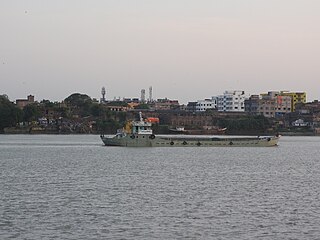
The National Waterway 1 (NW-1) or Ganga-Bhagirathi-Hooghly river system is located in India and runs from Prayagraj in Uttar Pradesh to Haldia in West Bengal via Patna and Bhagalpur in Bihar across the Ganges river. It is 1,620 km (1,010 mi) long, making it the longest waterway in India. It is of prime importance amongst all the national waterways considering its locational advantages. The NW-1 passes through West Bengal, Jharkhand, Bihar and Uttar Pradesh and serves major cities and their industrial hinterlands like;
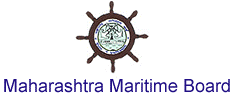
The Maharashtra Maritime Board is governmental organisation in the state of Maharashtra, India. The board is tasked with the administration of ports and harbours, conservancy, licensing of crafts, levying of fees, regulation and control of traffic. Maharashtra Maritime Board (MMB) came into existence in 1996 and Commissioner, Water Transport was re-designated as chief executive officer, MMB.

Kollam Port is one of the historic ports situated 4 kilometres (2.5 mi) away from Downtown Kollam ,14 km north of Paravur and 24 km north of Varkala Town It is the second largest port in Kerala by volume of cargo handled and facilities. Located on the south-west coast of India, under the name of Quilon Port it became one of the country's most important trade hubs from the ninth to the seventeenth centuries. Kollam was one of the five Indian ports visited by Ibn Battuta.
Water transport in India' has played a significant role in the country's overall economy and is indispensable to foreign trade. India is endowed with an extensive network of waterways in the form of rivers, canals, backwaters, creeks and a long coastline accessible through the seas and oceans. It has the largest carrying capacity of any form of transport and is most suitable for carrying bulky goods over long distances. It is one of the most cheap modes of transport in India, as it takes advantage of natural track and does not require huge capital investment in construction and maintenance except in the case of canals. Its fuel efficiency contributes to lower operating costs and reduced environmental impact due to carbon. India has 14500 km of inland waterways. Out of which only 5685 km are navigable by mechanized vessels.
Waterways have always been an important mode of transport in Kerala. The total length of navigable route in Kerala was 1,900 kilometres and the navigable rivers constitute about 54 per cent of the waterways. The 41 West-flowing rivers together with the backwaters are an integrated part of the inland navigation system in Kerala. In Kerala water transportation through these channels are mainly small distant passenger services, informal country boats,freight transportation to PSU's such as Fertilisers and Chemicals Travancore, Kochi etc.
Tom Jose is an Indian civil servant retired as the Chief Secretary, Government of Kerala. He is an Indian Administrative Service (IAS) officer belonging 1984 batch of Kerala cadre. Presently he is serving as Chairman of KSINC.
















